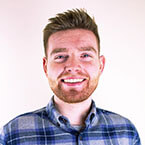Quick answer
Thematic maps transform the geographic data you already own into immediate competitive advantages. They turn static spreadsheets into predictive tools, shifting your strategy from reporting history to forecasting growth.
The impact
- Reveal the invisible: Exposes market patterns, risks, and opportunities that spreadsheets hide
- Predict action: Helps top teams identify exactly where to move next, rather than just reviewing past performance
- Decide faster: Converts complex data into visual clarity for instant, smarter decision-making
What is a Thematic Map?
A thematic map, or statistical map, is a type of map visualization designed to illustrate a particular dataset or attribute. As per the formal thematic map definition geography provides, thematic maps solely depict the distributions, densities, and patterns of a chosen theme or variable across a geographic area.
Thematic Maps Vs. Reference Maps
When it comes to thematic maps vs. reference maps, reference maps show physical landscape features or political boundaries, whereas thematic maps filter out those locating details. Instead, they use color, shading, symbols, and proportional symbols like scaled circles to highlight the spatial footprint of user-selected information.
Why Use Thematic Maps?
In short, a thematic map filters out unnecessary details about physical locations and terrain and spotlights solely on depicting distributions and densities of user-selected information. So, you see patterns in data instantly.
Common thematic mapping attributes include:
- Demographics like age, income level, and education
- Economic metrics like employment rates
- Business data such as sales performance, market share, or number of retail outlets
- Scientific information like climate factors, vegetation zones, and soil types
- Voting patterns and election result maps
- Disease rates and outbreak hotspots in public health
Businesses can leverage thematic maps in territory mapping software solutions to identify new expansion opportunities, optimize territories for sales and operations teams, locate ideal sites for new retail outlets, model service coverage gaps, improve marketing efficiency, pinpoint areas of high insurance risk, and more. Before we dive into the different types of thematic maps, read up on eSpatial's different types of maps and what they are used for.
Types of Thematic Maps
Certain thematic map types may prove more suitable than others depending on your specific business goals and available data sources. Some frequently used options include:
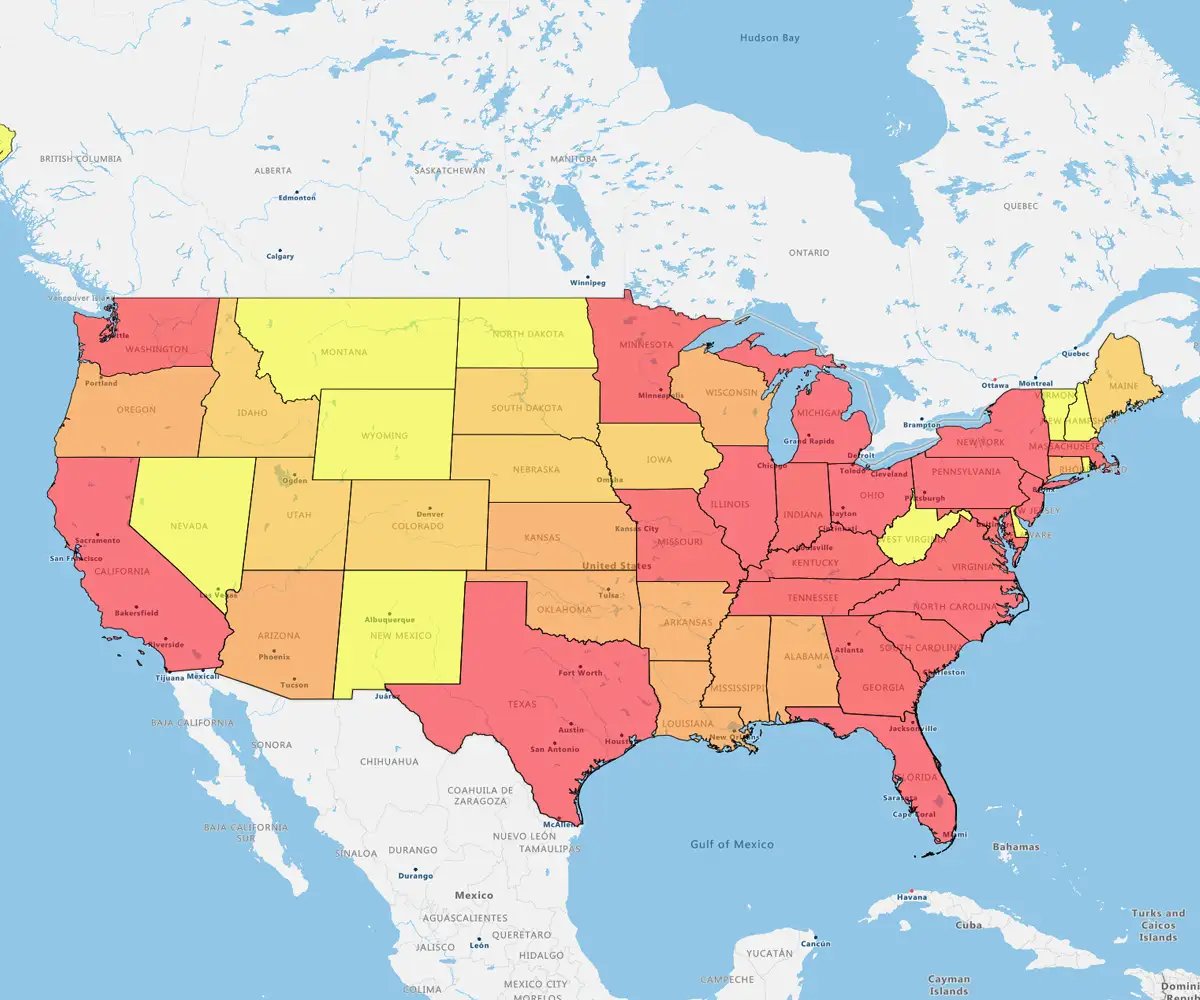
1. Choropleth Maps
Choropleth maps use color density or shading to depict differences in statistical values over a geographic area. Darker shades represent higher measured values, while lighter shades indicate lower values.
Some common attributes displayed in choropleth maps include:
- Population density
- Sales performance by territory/region
- Household income levels
- Election results/voting patterns
- Market penetration
- Crime rates
- Insurance claims rates
- Disease rates
Advantages
Choropleth maps excel at providing regional overviews for businesses. Use cases for Cholopleth maps include allowing operations, sales, and marketing teams to quickly visualize performance across territories at a high level and identify areas of opportunity or concern for further investigation.
Disadvantages
They can distort data by exaggerating abrupt changes at boundaries between areas. Subtle variations are sometimes hard to read. Additionally, these maps hide internal diversity, showing only average values within regions.
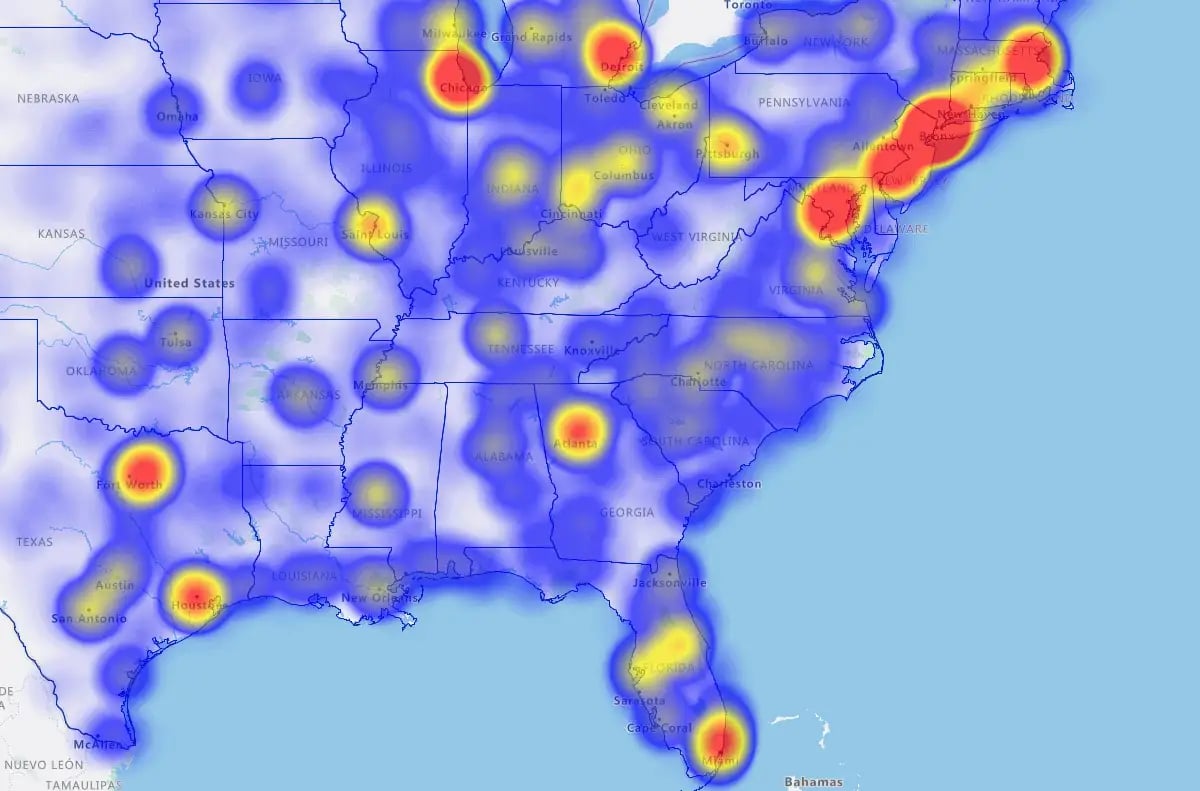
2. Heat Maps
Heat maps also use color to represent data variable intensity, but with more of a continuous color gradient. Like weather maps, which show temperature variations across a region, heat maps leverage a color scale to visually depict the density or concentration of a particular metric within a given area.
A subtype of heat maps is regional heatmaps. These summarize statistics like sales, customers, or market potential and color code regions based on the mapped variable's value.
Some typical applications of heat mapping are:
- Visualizing customer concentrations and hotspots of sales activity
- Displaying website click frequency and visitor engagement by locale
- Comparing market potential across regions to identify areas of growth
- Illuminating crime-rate patterns to support data-driven policing strategies
- Pinpointing disease outbreak hotspots and high-risk areas
Advantages
Political maps show country or state boundaries and divisions, focusing on geography rather than data patterns. In contrast, heat maps are thematic and highlight the intensity of data (like population, sales, or crime rates) across a region using color gradients.
With heat mapping software, businesses can zero in on the "hot spots" for a chosen metric, like revealing their most profitable sales regions and ideal sites for opening new locations. A good platform offers flexible geographic heat mapping to visualize custom location-based data.
Disadvantages
Heat maps can oversimplify data, hiding precise locations and fine details. The heat map may not reveal meaningful patterns if data points are too few or widely scattered.
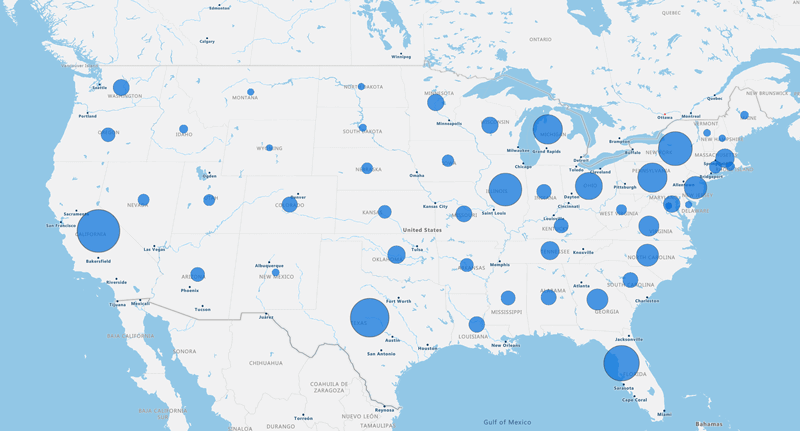
3. Bubble Maps
Unlike choropleth and heat maps, bubble maps use proportional symbols rather than color to depict variances in the mapped variable. Typically, the bubbles are scaled directly to the data attribute value, so a region with double the value would display a bubble twice the size.
Business applications of bubble maps include:
- Showing variation in market size, total customers, or buying power across regions
- Identifying highly saturated areas vs regions with room to grow
- Displaying demographic statistics like average household size
- Modeling retail site suitability based on the surrounding population reach
- Mapping gaps in service coverage relative to user demand
Advantages
As the physical map definition outlines, physical maps illustrate geographic elements like roads, cities, and landscape features. Thematic maps, like bubbles, filter these out and spotlight statistical attributes instead.
Disadvantages
Bubble maps can become cluttered and difficult to read when too many data points overlap. The size of the bubbles may also distort perception, making it hard to compare values accurately. Additionally, they often lack geographic precision
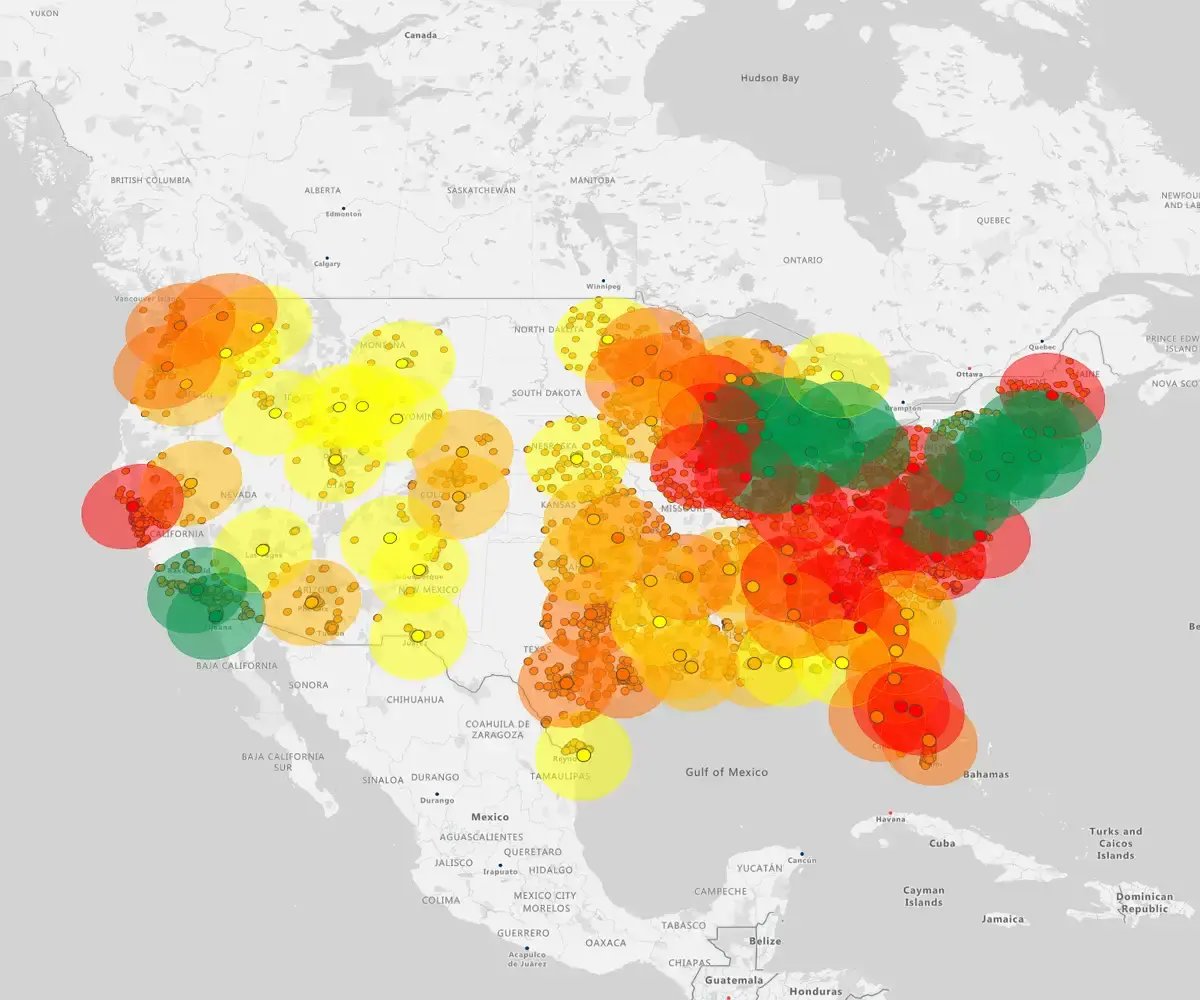
4. Radius Maps
Radius maps illustrate information about geographic points within a defined radius area. The radius boundary is typically centered around focus locations (such as existing stores). Read more about how to create a radius map.
Common radius map applications include:
- Showing customer locations within a few miles of each store
- Modeling service coverage capacity for a given radius
- Identifying gaps in coverage that new sites could fill
Advantages
Regions can be color-coded by the total metric value of enclosed points. For example, a coffee shop could map household spending power within 5 miles of proposed sites. Darker shader areas have greater buying power reach, guiding efficient location planning. Ultimately, radius maps can help businesses spot nearby opportunities and optimize locations based on surrounding demographics and activity.
Disadvantages
Radius maps can oversimplify data by assuming uniform impact within a set distance, which may not reflect real-world variables like travel time or terrain. They can also create visual overlap when multiple radii intersect. As they don't account for actual routes or accessibility, they’re not great for detailed planning.

5. Nearest Neighbor Maps
Nearest neighbor maps identify and display the closest point locations that match desired attributes or criteria. Typically, the mapped points feature distance lines connecting back to central positions.
Common examples include:
- Identifying the top 10 customer sites ordered by drive time proximity for optimal dispatch routing
- Finding the closest repeat-sales prospects to upsell based on past purchase locations
- Identifying gaps in sales coverage relative to customer proximity
- Spotting emerging local competitors to inform marketing responses
Advantages
Unlike general maps showing all roads and cities, nearest-neighbor analysis filters views to only the most important points based on proximity. For businesses, these maps can provide localized insights to help leaders make informed, location-based decisions.
Disadvantages
Nearest neighbour maps create sharp, artificial boundaries based only on straight-line distance, ignoring real-world factors like roads, terrain, or customer behaviour. They also can't show variations in demand or data density, making them less useful for complex analysis.
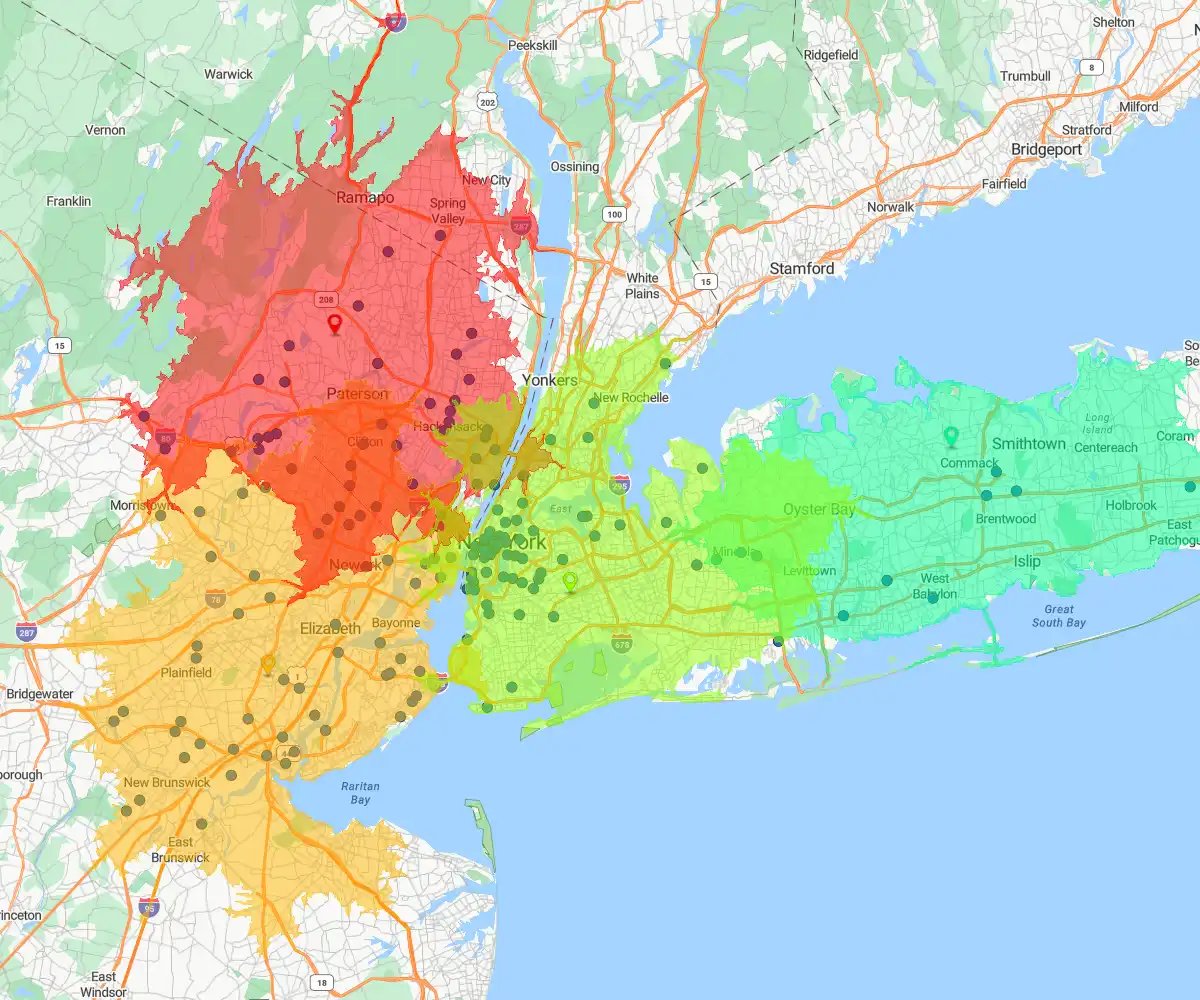
6. Drive Time Maps
As the name suggests, drive time maps delineate the area reachable within a specified drive time from target locations (such as warehouses). They illustrate areas reachable within set durations from each focus point.
Common example applications include:
- Mapping customers, competitors, or partners reachable within 15 minutes of each store for sales and marketing strategies
- Modeling 20-minute food delivery zones from a restaurant to balance order volume and logistics
- Identifying healthcare access gaps based on 30-minute drive times to facilities as a public health initiative
Advantages
Drive times analysis factors in travel speeds, road infrastructure, and regional geography, providing businesses with more realistic data that helps them make informed decisions.
Disadvantages
Drive time maps depend on estimated travel speeds, which can change with traffic or roadworks. They assume consistent driving conditions. They can't account for customer preferences or non-driving travel, so real service areas may differ.
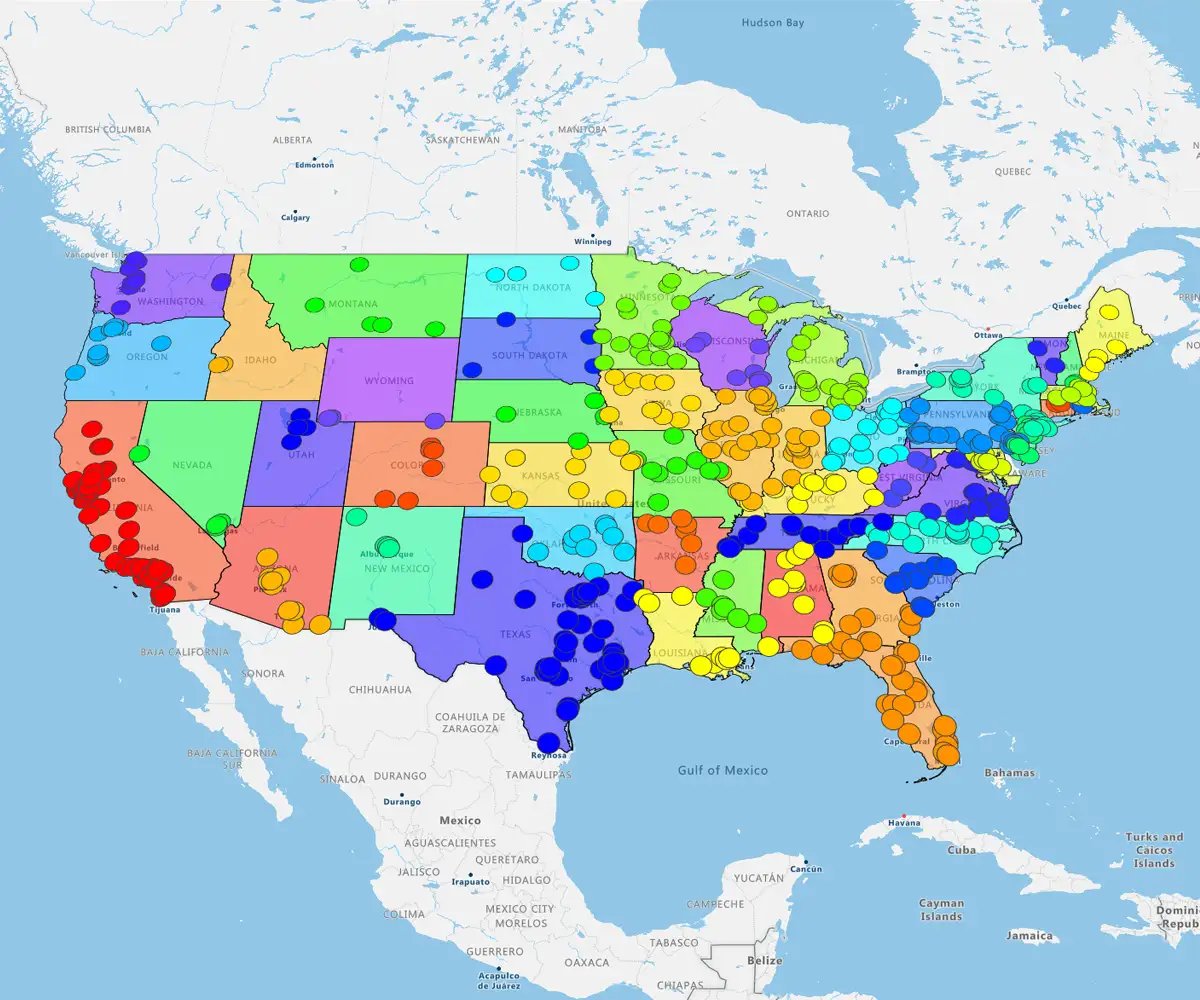
7. Aggregate-by Value Maps
Aggregate-by-value maps categorize records based on a variable and then display summarized statistics by region. These maps help segment populations into groups for comparison.
Typical business uses include:
- Sales segmented by deal status for performance analysis
- Service cases categorized by issue type and priority level
- Grouping customers into value tiers
- Product sales aggregated by item family
Advantages
For example, a retail chain could use an aggregate-by-value map to break out sales by product category over the past quarter. The map would shade regions based on the total sales value from categories like apparel, electronics, home goods, and groceries. This allows businesses to visually identify differences in buying patterns across regions. The intelligence fuels targeted marketing and tailored inventory by location.
Disadvantages
These maps can hide local details by summarizing data into larger areas. If boundaries aren't chosen carefully
Creating Effective Thematic
Maps for Business Purposes
With so many possible applications, thematic maps deliver immense value to business intelligence workflows. But simply having access to mapping capabilities doesn't guarantee effective results. Creating handy thematic maps requires carefully designing around the specific business need by using the right inputs, methodology, and tool configuration.
When creating a thematic map, it's critical to follow best practices:
1. Choose the right map type
Select the map type that will best highlight the precise data patterns and distributions you need to analyze for your business purpose. Match choropleth maps to regional overviews, heat maps to intensity, bubbles for totals, etc.
2. Input data
Flawed data destroys the reliability of any map's insights. Before mapping, validate information accuracy, fill gaps, structure data, geocode records, and normalize metrics.
3. Incorporate analytical features
Configure tools to automatically surface patterns plus allow custom analytics like thresholds, segmentation, change comparisons over time, blended data views, demographic expansion, and more.
By following best practices and continuously improving maps over time, your thematic creations will yield progressively richer and more actionable business value. Combined with mapping technologies, users can rapidly generate location intelligence at their fingertips.
Use Cases of Thematic Maps in Business
Different types of thematic maps can be used for specific business insights. Here are some examples of what thematic maps are used for:
Use case 1
Sales Strategy & Territory Planning
Heat and choropleth maps reveal high-performing regions and whitespace opportunities. For instance, businesses can utilize geographic sales data to identify underserved markets and realign resources accordingly.
Use case 2
Competitor Mapping & Market Positioning
By overlaying competitor locations, companies identify areas of saturation or advantage, helping to guide expansion decisions and defend market share.
Use case 3
Customer Segmentation & Targeted Campaigns
Heat mapping customer demographics or sales volume enables tailored marketing strategies. For example, clustering high-value customers supports precise campaign targeting.
Use case 4
Logistics & Route Optimization
Firms streamline delivery and service operations by visualizing stops and travel times. Thematic layers, like density or drivetime zones, enhance route planning efficiency.
Use case 5
Site Selection & Expansion Planning
Businesses choose optimal locations for new offices or stores based on demographic, competitor, and customer activity overlays.
Mapping Solutions For
Businesses From eSpatial
As a leader in location intelligence software, eSpatial's powerful mapping software offers a full suite of thematic mapping capabilities to empower strategic business growth. With the flexibility to instantly map company data like operations, manufacturing, or delivery sites, sales, customer sites, and service events, the eSpatial platform reveals hidden geographic insights without requiring extensive GIS knowledge.
So, why wait? Gain a location-based competitive edge from thematic views of your most vital metrics. Start creating your territory maps immediately with our territory mapping software and territory management solutions. Contact us today for a customized demo!
Frequently Asked Questions
My Team is Drowning in Spreadsheet Data, and Our Charts in Power Bi Aren't Telling a Clear Story. How Can a Thematic Map Show Me Where Our Marketing is Actually Working and Where the Opportunities Are, Without Me Needing a Data Science Degree?
We understand that feeling completely. Spreadsheets and standard charts can show you what is happening, but they often fail to show you where. A thematic map is designed to solve this. Instead of complex tables, you can instantly see your data as a color-coded map. For example, you can create a heatmap showing sales performance by zip code or county. This immediately reveals your high-performing "hotspots" and under-served "cold spots." It's an intuitive, visual way for marketers to see the geographical story in their data, allowing you to pinpoint opportunities and allocate your budget more effectively, all without needing a technical background.
I'm Trying to Identify New Site Locations, but Plotting Individual Addresses on a Map Doesn't Give Me the Market Context I Need. How Can I Use a Thematic Map to Instantly See and Compare Areas With the Highest Concentration of My Ideal Customers?
That's a critical limitation of basic mapping. Plotting single points doesn't reveal the underlying opportunity of an area. With a thematic map, you can move beyond dots on a map to a full market view. You can upload your customer data and instantly create a color-coded map that visualizes market penetration or sales potential across entire regions. By layering this with demographic data, you can see, for example, which neighborhoods have the highest concentration of your ideal customer profile but the lowest sales. This allows you to compare potential sites based on rich, visual market context, ensuring you make expansion decisions based on data, not guesswork.
We Have Tons of Customer Data, but It's Hard to Spot Regional Trends or Outliers Using Pivot Tables Alone. Can I Use a Thematic Map to Visually Segment My Customer Data and Find Our Most Profitable Regions or Surprising "white Space" Opportunities?
Absolutely. This is a core strength of thematic mapping and a common frustration with pivot tables. In eSpatial, you can easily create a thematic map that color-codes your territories based on any metric you choose—like sales volume, customer count, or product penetration. This immediately draws your eye to regional patterns. You'll instantly spot the outlier regions that are over- or under-performing. More importantly, you'll uncover hidden "white space"—untapped markets that are geographically close to your strongholds but are currently being ignored. These are the revenue opportunities that remain invisible when your data is trapped in rows and columns.
My Current Bi Tool Can Create Basic Maps, but They Feel Static and Don't Help Me Tell a Story to My Leadership Team. How Does eSpatial Help Me Create Compelling Visual Stories That Actually Lead to Confident Decisions on Where to Focus Our Budget and Resources?
We hear this a lot. The difference is between a static picture and an interactive story. While many BI tools can place dots on a map, eSpatial allows you to create dynamic, layered visualizations that build a powerful narrative. You can show not just current performance but also potential, overlaying sales data with market demographics to clearly illustrate why a certain region is an opportunity. You can filter, query, and drill down into the data live during a presentation, answering questions on the fly. This turns your map from a simple report into a compelling business case that gives leadership the confidence to make faster, more informed decisions.
We Need to Plan a Targeted Marketing Campaign, but Doing the Demographic Analysis in Excel is Slow and Painful. How Can I Use Thematic Maps to Quickly Layer Our Sales Data Over Demographic Data to Plan and Execute Campaigns Much Faster?
The manual process of matching demographic data to sales data in Excel is exactly the kind of time-consuming work we aim to eliminate. With eSpatial, you can upload your customer or sales data and instantly layer it with our built-in demographic datasets (like income, age, or population density). A thematic map will then visually show you the "bullseye"—the exact areas where your highest sales overlap with your key demographics. This allows you to define hyper-targeted campaign zones in minutes, not days, ensuring your marketing efforts are focused on the areas with the highest probability of success.
I'm Worried That Creating These Kinds of Maps Will Be Another Complex It Project Requiring Me to Constantly Ask for Help. How Can My Team and I Get Started Quickly and Create Our Own Thematic Maps Without Needing Extensive Training or Technical Support?
This is a key concern for many teams, and we've designed our platform to be powerful for analysts yet simple enough for any business user. You can get started in minutes by simply uploading a spreadsheet. Our interface is intuitive and visual, with straightforward controls for creating even complex thematic maps. The goal is to empower you and your team to be self-sufficient, turning data into insights without creating a ticket for IT or waiting for an analyst. This focus on user-friendliness drives high adoption and ensures you get value from day one.
Our Data is Sensitive, and I'm Always Hesitant to Upload It to a New Platform. How Does eSpatial Ensure the Security of My Customer and Sales Data When I'm Using It to Create Maps?
We treat data security as our highest priority. We understand that your location and customer data is one of your most valuable assets. eSpatial is built on world-class, secure cloud infrastructure that employs enterprise-grade security standards to keep your data safe. We ensure that your data is protected both in transit and at rest, and provide robust user permissions and controls so you always have full command over who sees what. You can be confident that your sensitive information is secure within our platform.
I Need to Convince My VP That This is a Worthwhile Investment. How Can I Demonstrate the ROI of Using Thematic Maps to Move Beyond Our Current Spreadsheets and Bi Tools and Show a Clear Link to Better Marketing Performance or More Strategic Site Selection?
The ROI of thematic mapping goes far beyond saving time on spreadsheets. It's about the quality and speed of your decisions. You can build a clear business case by focusing on outcomes:
-
For Marketing Teams: Show how visualizing marketing performance prevents wasted ad spend in underperforming regions and helps identify new, high-potential markets, directly linking the tool to more efficient growth.
-
For Operations or Expansion Teams: Demonstrate how a data-driven site selection process reduces the risk of costly failures and increases the likelihood of placing new locations in optimally profitable areas. In short, eSpatial turns your geographic data from a complicated asset into a clear competitive advantage, driving smarter, faster decisions that have a direct impact on the bottom line.

